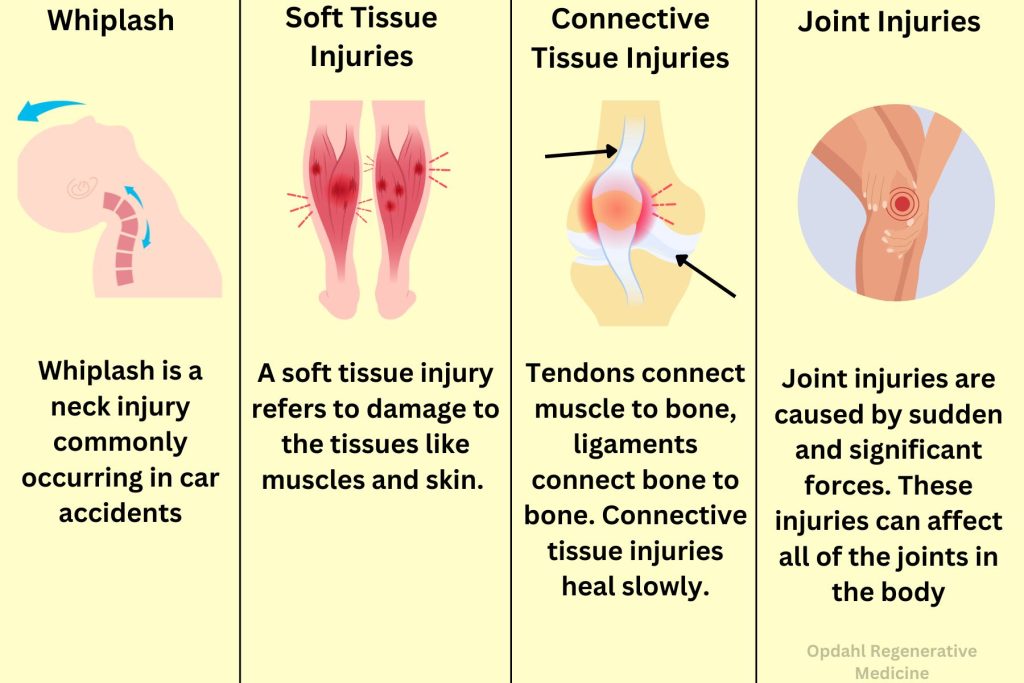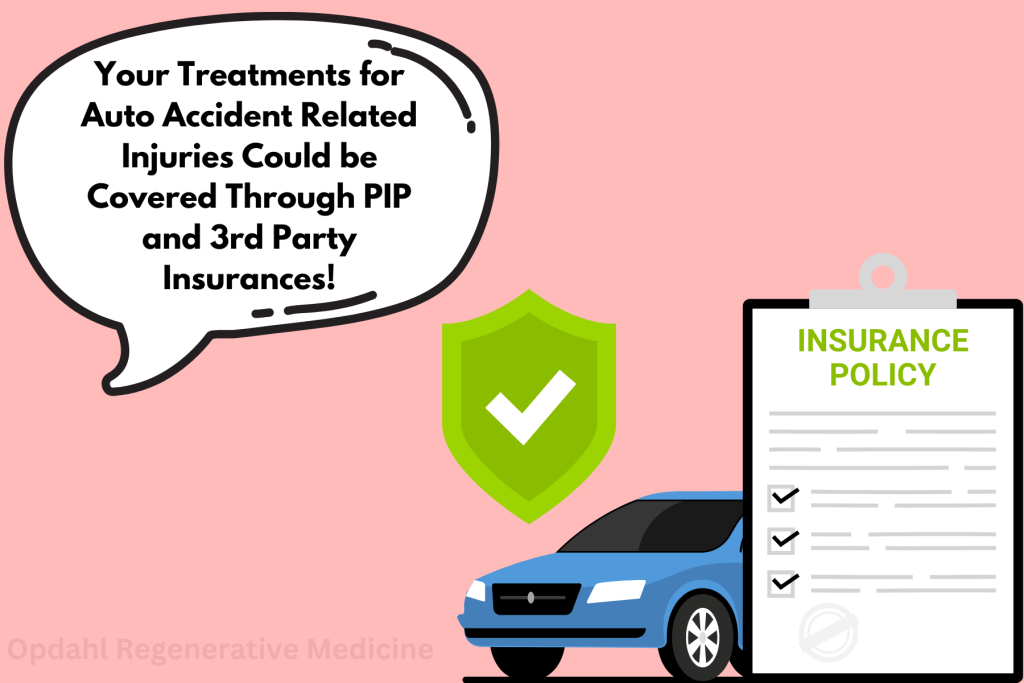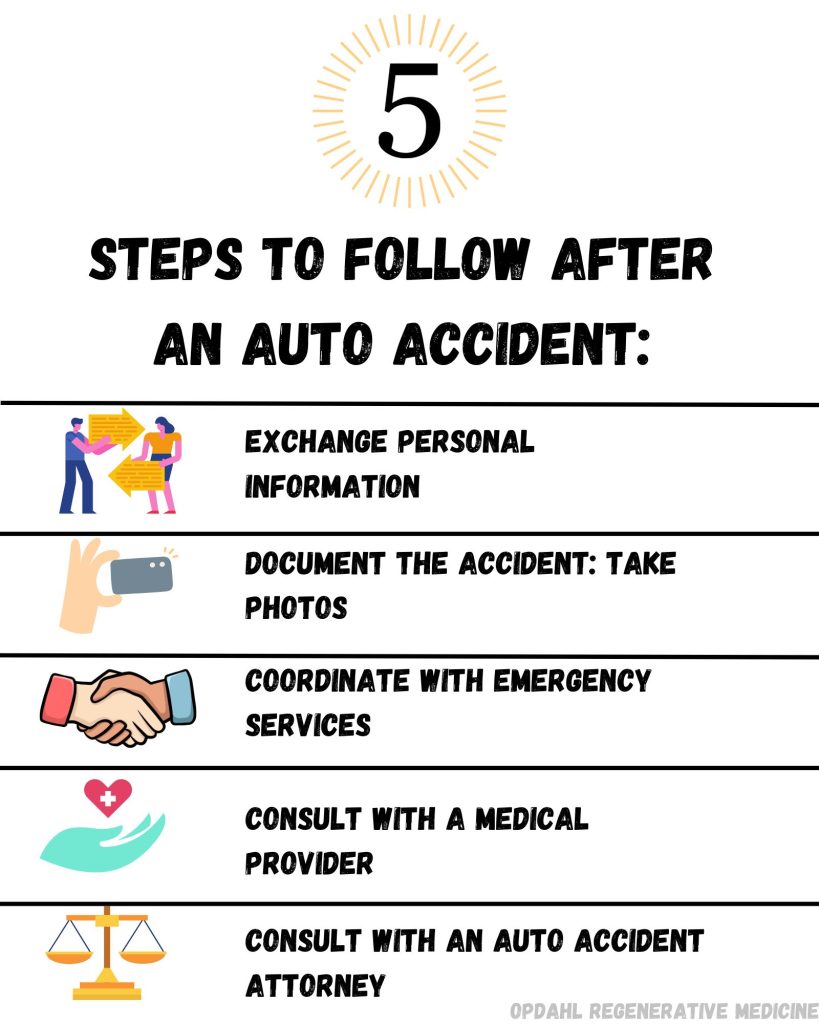An auto accident is a traumatic event that can leave lasting physical and emotional scars. From whiplash to broken bones, the injuries sustained in these incidents can significantly impact a person’s quality of life. However, amidst the challenges of recovery, there’s a beacon of hope: Regenerative Medicine.
Regenerative medicine is a cutting-edge field that focuses on harnessing the body’s natural ability to heal and regenerate damaged tissues. Unlike traditional treatments that merely manage symptoms, regenerative medicine offers a holistic approach to healing, addressing the root cause of injuries and promoting long-term recovery. For auto accident patients, the benefits are profound and transformative

Auto Accident Injuries
- Whiplash: Whiplash occurs when the neck is forcefully jerked back and forth, often due to the sudden impact of a car accident. This can result in soft tissue injuries, connective tissue injuries, muscle strain, and ligament damage.
- Soft Tissue Injuries: Auto accidents can cause a range of soft tissue injuries, including muscle strains, and tears, skin bruising, and lacerations.
- Connective Tissue Injuries: Auto accidents can cause connective tissue injuries like tendon and ligament injuries due to sudden impact, excessive stretching, or twisting forces exerted on the body, often resulting in tears or strains in these tissues.
- Joint Injuries: Auto accidents can place significant stress on the body’s joints, leading to injuries such as dislocations, sprains, and cartilage damage. These injuries can cause pain, swelling, and limited range of motion.

Regenerative Medicine For Auto Accidents:
Accelerated Healing:
One of the primary benefits of regenerative medicine is its ability to accelerate the healing process. Therapies such as platelet-rich plasma (PRP) injections and stem cell therapy introduce concentrated doses of healing factors and growth factors directly to the site of injury, stimulating the body’s natural repair mechanisms. This targeted approach can significantly reduce recovery time and promote faster return to normal activities.
Reduced Pain:
Auto accident injuries often result in chronic pain that can persist long after the initial trauma has healed. Regenerative medicine offers effective pain relief by reducing inflammation, repairing damaged tissues, and restoring function to injured areas. By addressing the underlying cause of pain, rather than merely masking symptoms with medication, patients can experience long-lasting relief and improved quality of life.
Improved Mobility and Functionality:
Auto accident injuries can impair mobility and limit functionality, making everyday tasks difficult or impossible to perform. Regenerative medicine helps restore mobility and functionality by promoting tissue repair and regeneration. Whether it’s repairing damaged ligaments, cartilage, or muscles, these therapies facilitate the restoration of normal movement patterns, allowing patients to regain independence and quality of life.
Long-Term Results:
Perhaps one of the most significant benefits of regenerative medicine is its potential for long-term results. By stimulating the body’s natural healing mechanisms, these therapies address the underlying cause of injuries, rather than simply masking symptoms. This holistic approach not only promotes faster recovery but also reduces the risk of future complications, allowing patients to enjoy lasting improvements in health and well-being.
Avoid Surgery:
These regenerative therapies capitalize on the body’s innate ability to heal itself. What sets these treatments apart is their ability to circumvent the need for invasive surgery. By nurturing the body’s natural healing mechanisms, regenerative medicine offers a pathway to recovery that minimizes the risks, discomfort, and prolonged recovery associated with surgical interventions.
How Much Does Treatment Cost?
Auto accidents can be financially burdensome, with medical expenses quickly adding up. However, when it comes to regenerative medicine for auto accident patients, there is a silver lining. Personal Injury Protection (PIP) insurance and third-party insurance coverage often extend to cover regenerative medicine treatments.
PIP insurance, also known as “no-fault” insurance, is a type of coverage that helps pay for medical expenses and other related costs resulting from auto accidents, regardless of who was at fault. PIP insurance is mandatory in some states and optional in others. To find out if you have PIP coverage, you can check your auto insurance policy or contact your insurance provider directly.
If you have PIP coverage, you may be eligible for reimbursement or direct coverage of regenerative medicine treatments such as platelet-rich plasma (PRP) injections and stem cell therapy. This coverage can significantly alleviate the financial strain on patients, ensuring they have access to the innovative treatments they need to facilitate their recovery.

What If I Don’t Have PIP Coverage?
Third-party insurance coverage may come into play if another party is found liable for the auto accident. In such cases, insurance policies of the at-fault party may cover regenerative medicine treatments as part of the overall settlement. This provides further reassurance to patients that financial assistance is available to support their journey toward healing and rehabilitation.
Accessibility of Regenerative Medicine:
Outpatient Treatment Options
Regenerative Medicine is becoming a more popular and accepted method of treatment for tricky joint issues. There are expanding numbers of outpatient clinics with advanced treatment options. Many regenerative medicine procedures can be performed in settings such as clinics or specialized treatment centers, rather than in hospital environments. This not only enhances convenience for patients but also reduces the burden on healthcare facilities and resources, making it easier for individuals to access the care they need in a timely manner. Additionally, outpatient treatments often require less scheduling flexibility and logistical planning, further lowering the barriers to access for patients seeking regenerative medicine therapies.
Recovery Time for Regenerative Medicine Treatments:
Recovery time is a significant consideration for individuals undergoing medical procedures, including regenerative medicine interventions. Unlike traditional surgical procedures, which often entail lengthy recovery periods and post-operative restrictions, regenerative medicine treatments are generally associated with shorter recovery times and fewer limitations. However, the specific recovery process can vary depending on the type of regenerative medicine procedure performed and individual factors such as the patient’s overall health, the severity of the condition being treated, and the presence of any underlying medical conditions.
Immediate Return to Activities:
In many cases, patients undergoing regenerative medicine procedures can resume their normal activities shortly after treatment. Unlike surgeries that may require days or weeks of post-operative rest and rehabilitation, regenerative medicine interventions often allow patients to return to work, exercise, and other daily activities immediately or within a short time frame. This quick recovery enables individuals to maintain their usual routines and responsibilities while undergoing treatment, minimizing disruptions to their lifestyle.
How Long Will it Take for My Condition to Improve?
While some patients may experience immediate relief or improvement following regenerative medicine procedures, it’s important to understand that the full benefits of treatment may unfold gradually over time. Regenerative medicine works by stimulating the body’s natural healing processes, which can take weeks or months to fully manifest. Patients undergoing regenerative medicine interventions should maintain realistic expectations and understand that the pace of recovery may vary. Consistent communication with healthcare providers and adherence to recommended treatment protocols can help maximize the effectiveness of regenerative medicine therapies and support long-term healing and recovery.
5 Steps to Follow After an Auto Accident:

In the aftermath of an auto accident, swift and methodical action is vital. Remember to exchange personal information with the involved parties and document the scene thoroughly, capturing photos of any damage or relevant details. Coordinate with emergency services to ensure everyone’s safety and well-being. Following this, seek medical attention promptly to address any injuries, no matter how minor they may seem. Lastly, consider consulting with an experienced auto accident attorney who can provide guidance and support throughout the legal process. By following these steps, you not only safeguard your health and rights but also pave the way for a smoother recovery and resolution.
Learn More About Alternative Ways to Alleviate Your Pain
Get back to doing the things you love, faster & without surgery.
Request an Appointment Today!